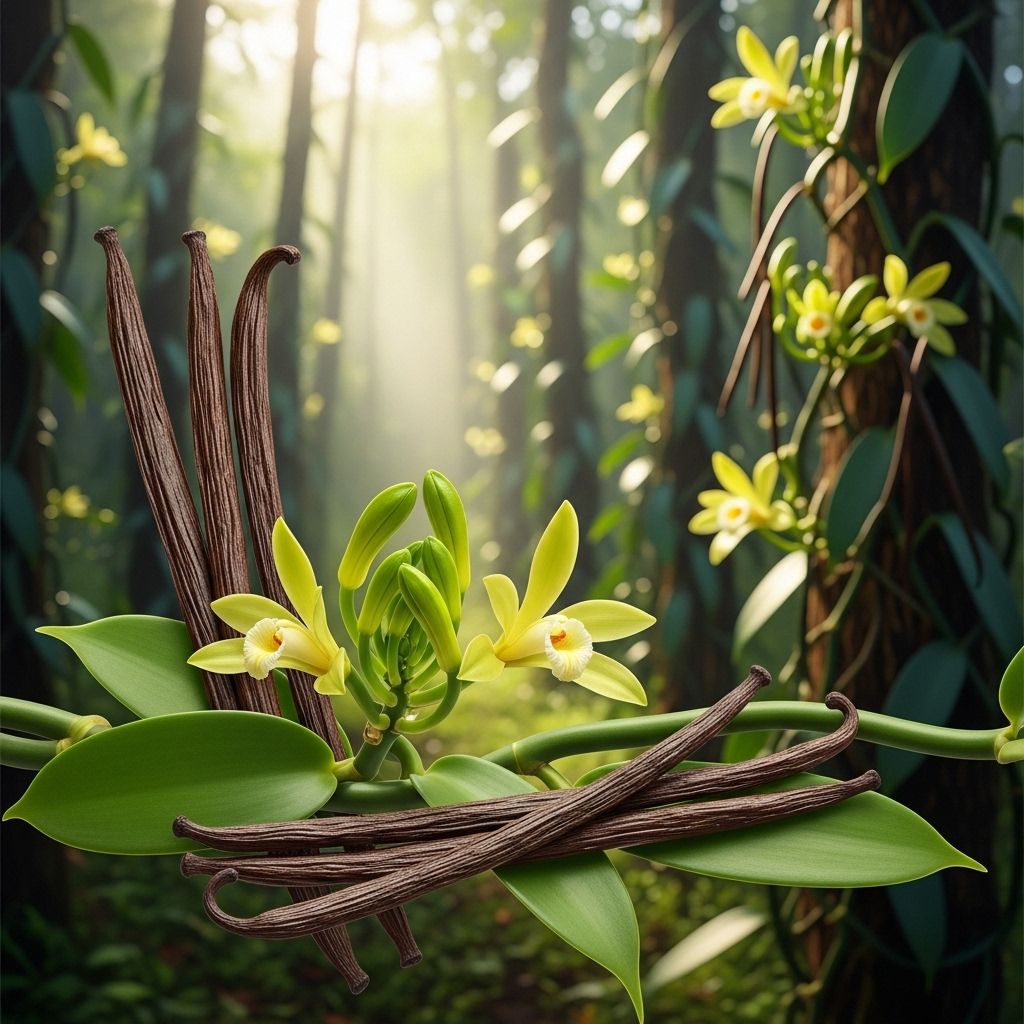Where Do Vanilla Beans Come From? The Journey from Orchid to Extract
Hand pollination and meticulous curing bring out vanilla’s signature flavor profile.

Where Do Vanilla Beans Come From?
Vanilla, one of the world’s favorite flavors, boasts an exotic origin story that spans continents, centuries, and a complex journey from fragrant tropical orchids to the rich extract in your kitchen. This intricate process involves hand pollination, months of careful tending, and a demanding curing regimen. Let’s follow the remarkable lifecycle and world journey of the vanilla bean.
The Botanical Origins: Vanilla as an Orchid
Vanilla is not a typical plant—it is actually a genus of tropical climbing orchids. Three major species dominate commercial cultivation, with all varieties originating from Mesoamerica, especially modern-day Mexico. Vanilla planifolia is the most widely grown, cherished for both its flavor and agronomic characteristics.
These orchid vines produce stunning, pale-greenish flowers that open for only a single day—an evolutionary quirk that makes vanilla both precious and difficult to produce. The beans themselves are actually pods (botanically, capsules) that result once these flowers are pollinated.
- Main commercial species: Vanilla planifolia (also called Bourbon or Madagascar vanilla), Vanilla tahitensis (Tahitian vanilla), and Vanilla pompona (West Indian vanilla).
- Natural habitat: Humid, equatorial tropical forests within 10-20 degrees latitude of the equator.
- Growth habit: Vigorous, climbing vines often trained up supporting trees or trellises.
Cultural and Historical Roots of Vanilla
The Totonac people of Mexico were the first to domesticate vanilla, using it for both culinary and ceremonial purposes as early as the 12th century. Later, following conquest, the Aztecs began combining vanilla with cacao in the famous drink “xocolatl,” a luxury beverage that inspired today’s chocolate traditions.
Europeans first encountered vanilla after the Spanish conquest of Mexico in the 16th century. The conquistadors brought both vanilla and cacao to the Old World, where it quickly became a coveted, exotic treat among the elite. For centuries, all commercial vanilla came from Mexico, dependent on a special local bee—the Melipona—to pollinate the flowers.
Early Commercialization and Spread
- 1520: Spanish conquistadors encountered “chocolatl,” a cacao-and-vanilla drink, and sent vanilla beans to Europe.
- 1585: First commercial shipment of vanilla (and cocoa) from Mexico to Spain.
- 19th century: Global vanilla cultivation expanded after the discovery of hand pollination.
The Natural Home of Vanilla: Where Is It Grown Today?
Originally, vanilla’s range was tightly limited to Mesoamerica, but today its cultivation stretches across many humid, equatorial regions, with the most famous coming from:
- Madagascar: The top global producer, renowned for high-quality Bourbon vanilla.
- Mexico: The orchid’s native home and source of traditional vanilla flavor.
- Tahiti: Source of the unique Vanilla tahitensis, with a distinctive floral aroma.
- Uganda, Indonesia, Réunion Island, and Papua New Guinea—emerging and established regions producing distinct vanilla beans.
Suitable climate is key: vanilla orchids thrive in regions boasting heavy rainfall, warm temperatures, and rich, well-draining soils.
The Intricate Lifecycle: How Vanilla Beans Are Grown and Harvested
Growing vanilla is exceptionally laborious and detail-oriented. It often takes up to four years from the time a cutting is planted before the first beans are harvested.
Propagation and Flowering
- Planting: Vanilla is commonly propagated via stem cuttings, which are planted beside supports and allowed to root and climb.
- Flowering: Vines must first reach maturity, which can take 2-4 years. Mature vines produce clusters of delicate, yellow-green orchid flowers once annually.
Pollination: A Task for Human Hands
In their native Mexico, vanilla orchids are pollinated by the tiny Melipona bee. Outside this region, natural pollinators are absent, so humans must painstakingly pollinate each flower by hand—a skill-intensive task typically performed early in the morning when the flowers are receptive.
- Each flower must be pollinated within 12 hours, or it will wither away.
- Edmond Albius, in 1841 on Réunion Island, perfected the now-standard manual pollination technique.
- Hand pollination opened the global vanilla industry, allowing successful cultivation throughout Madagascar, Tahiti, and beyond.
Bean Development: Patience Pays Off
- After pollination, the flowers develop into long green pods—or vanilla beans—over the course of 6-9 months.
- Pods change from green to yellow, signaling readiness for harvest.
Harvesting the Beans
- Precision harvest: Beans must be picked at the optimum moment—generally when the tip just begins to split—while still firm and fully developed.
The Curing Process: Unlocking Vanilla’s Signature Flavor
Freshly harvested vanilla pods are relatively odorless. Their evocative aroma and deep flavors develop only through a complex, months-long curing process that triggers a cascade of chemical changes—including enzymatic breakdown and fermentation.
The Four-Stage Curing Process
- Killing: Beans are briefly immersed in hot water or exposed to sunlight to halt further growth.
- Sweating: Pods are kept warm and humid, often in sweat boxes, to ferment and promote the development of aromatic compounds like vanillin.
- Drying: Beans are laid out in the sun during the day and covered at night for several weeks, losing up to 80% of their weight.
- Conditioning: Dried beans ripen further in loosely packed boxes for several months, developing complexity, mellowness, and distinctive regional flavor notes.
Regional Curing Differences
- Madagascar: Farmers typically begin with a hot water bath, intensifying flavor development.
- Mexico: Traditional sun-and-shade drying; fermentation is allowed to progress slowly over several weeks.
- Tahiti: Unique sun-curing process, designed to preserve the delicate floral notes of Vanilla tahitensis.
Top-Producing Vanilla Regions and Flavor Profiles
| Region | Main Species | Flavor Notes | Unique Points |
|---|---|---|---|
| Madagascar | V. planifolia | Sweet, creamy, rich | Bourbon vanilla; most widely used globally |
| Mexico | V. planifolia | Spicy, woody, mellow | Historic origin; traditional pollination technique |
| Tahiti | V. tahitensis | Floral, fruity, anisic | Distinct species; prized in perfumery & gourmet pastry |
| Uganda | V. planifolia | Bold, earthy, chocolatey | Emerging premium producer |
Why Is Vanilla So Expensive?
Several factors combine to make vanilla the world’s second most expensive spice after saffron:
- Labor-intensive hand pollination, required for every flower outside vanilla’s native home.
- Long maturation time—vines take years before flowering, beans need 6-9 months to develop, and curing takes up to 6 months more.
- High risk of crop failure, due to disease, weather, and theft.
- Small-scale production: Beans are largely grown by independent family farmers or small cooperatives.
From Bean to Extract: Final Steps
The journey still isn’t over. Once fully cured, vanilla beans are sorted for quality and either sold whole (for gourmet cooking) or used to produce vanilla extract. Premium extracts soak chopped vanilla beans in an alcohol-water mixture for months, slowly extracting the rich vanillin and hundreds of aromatic compounds that define real vanilla’s unmatched complexity.
By contrast, artificial vanilla extract (vanillin) is usually derived from lignin or guaiacol, producing only a fraction of the flavor complexity found in real vanilla beans.
Vanilla at a Glance: Quick Facts
- Scientific name: Vanilla planifolia (main commercial species).
- Origin: Native to Mexico, now grown in Madagascar, Tahiti, Indonesia, Uganda, and other tropical regions.
- Flowering: Once annually, flowers are open just for a few hours.
- Pollination: Performed manually in most regions except native Mexico.
- Harvest timing: Around 8-9 months after pollination.
- Curing process: 3–6 months with regional variations.
- Uses: Flavor for culinary, perfumes, aromatherapy.
Frequently Asked Questions (FAQs)
Q: Why can’t vanilla be grown more widely?
A: Vanilla requires a very specific tropical climate and careful, skilled hand pollination, making it very sensitive to growing outside a narrow geographical band near the equator.
Q: How can I tell real vanilla from artificial?
A: Real vanilla extract will list vanilla bean extractives and sometimes show seeds or a deep brown color; artificial (imitation) vanilla is clear or very lightly tinted and has a much simpler aroma profile.
Q: Why do some vanilla beans look oily and others dry?
A: Oily beans have retained more moisture and are generally fresher, while drier beans have been aged longer or allowed to dehydrate more in the curing process. Both can be high quality if properly cured.
Q: Can I grow vanilla at home?
A: It’s possible in greenhouses or warm, humid climates, but pollination must be done by hand and the process is lengthy. Most home gardeners find it challenging but rewarding if successful.
Q: What gives vanilla its unique flavor?
A: The signature aroma and flavor come mainly from vanillin, but over 250 volatile compounds contribute to the complexity of natural vanilla beans, especially after the meticulous curing process.
Conclusion
The journey of the vanilla bean from tropical orchid to fragrant kitchen staple is a remarkable tale of history, human ingenuity, and nature’s complexity. Grown by patient hands in lush tropical locales, each vanilla bean embodies years of careful labor and centuries-long culinary tradition. By understanding where vanilla comes from and what sets genuine beans apart, you can better appreciate the treat that is true vanilla—whether in your favorite dessert, beverage, or homemade extract.
References
Read full bio of Srija Burman












